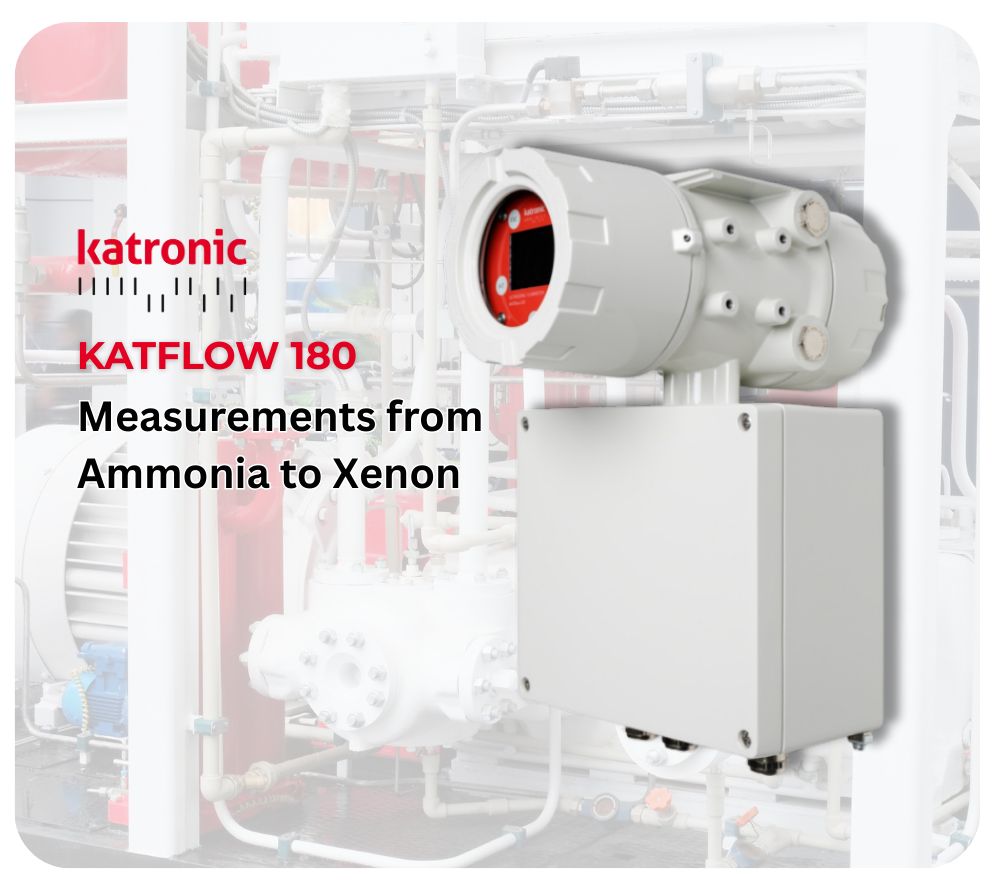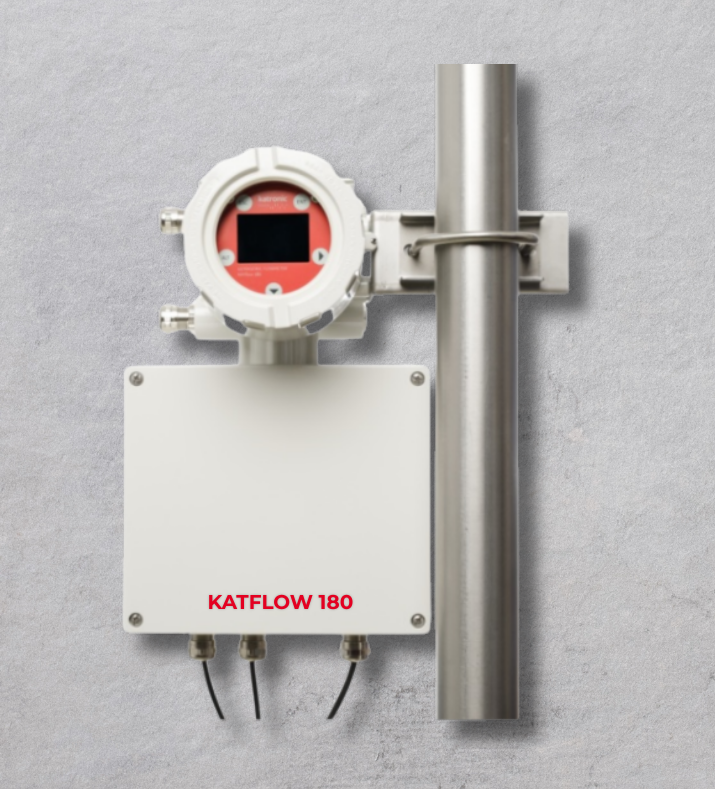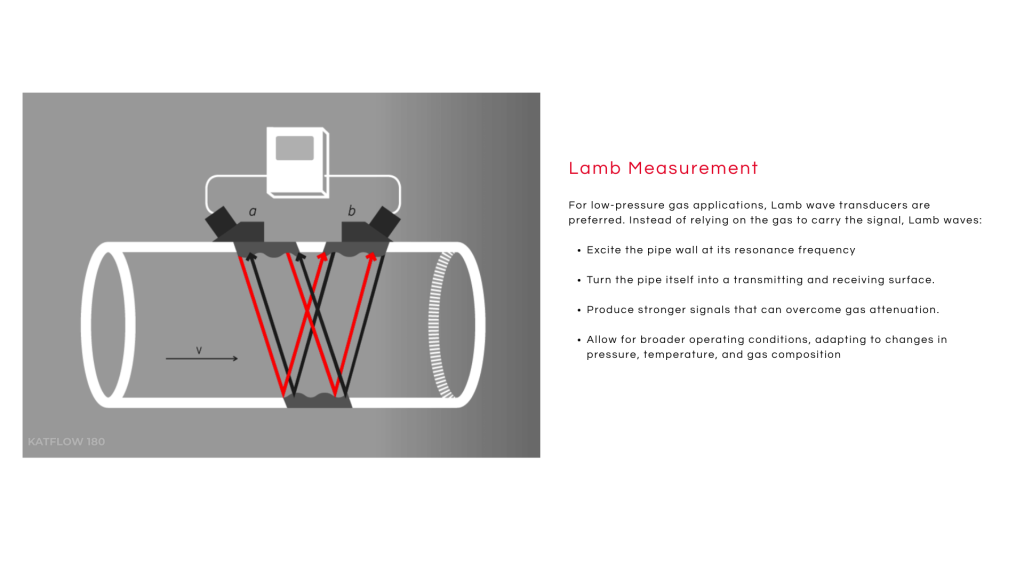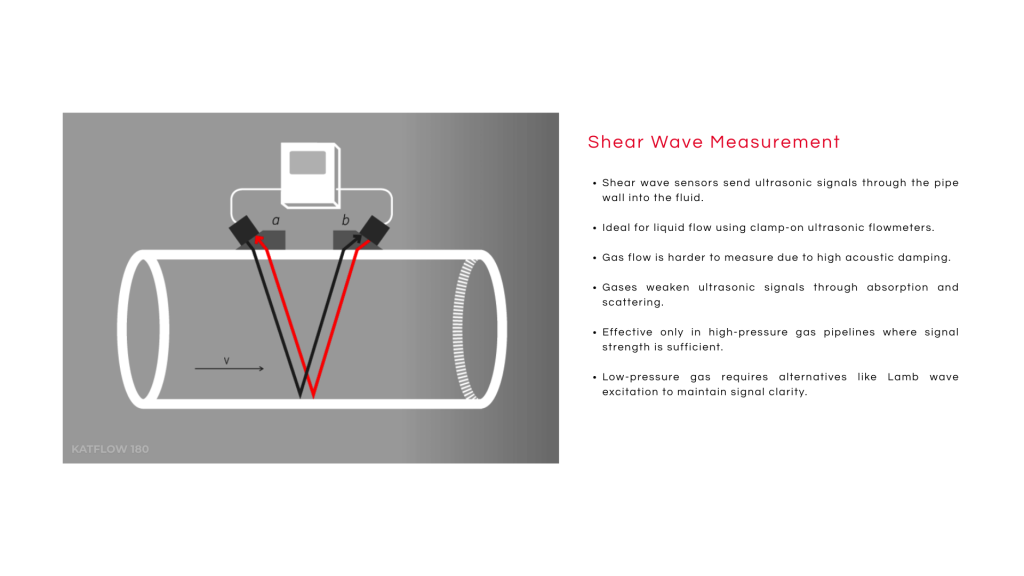KATflow 180
Measurements from Ammonia to Xenon
The new KATflow 180 represents the culmination of many years of development in the field of ultrasonic technology. It has been designed to provide a reliable measurement on varying applications from high pressure flow systems to locations where in the past clamp-on devices would not have been considered suitable. Unlike other instruments the new meter can be installed on metallic gas pipes where the pressure is far lower than the recognised five bar minimum, with measurement possible down to atmospheric conditions. This is achieved through a combination of powerful sophisticated electronics, adaptive filtering techniques and innovative signal processing algorithms using Digital Signal Processors (DSPʼs).

With the innovations introduced by Katronic in the KATflow 180 it is possible to measure flow of a variety of different gaseous media from 0.1 to 75 m/s. The advanced transducer assembly economically offers both shear and Lamb wave measurements with a minimum number of sensors, for greater simplicity. The unit is available for permanent use in both safe and hazardous environments with rugged housings for Zones 1 and 2. The KATflow 180 is easily programmed with a magnetic pen for increased safety and can measure on all commonly used pipe materials.

Versatile gas flowmeter designed for pipe diameters from 10 to 3000 mm, featuring IP66 protection, ATEX certification, and advanced temperature and pressure compensation for accurate multi-gas measurement in demanding environments.
How does Gas Flow Measurement work?
When we took the decision to begin the development process of a new gas clamp-on ultrasonic flowmeter we had two clear goals in mind: To be able to provide accurate and reliable flow measurements, and to do so on applications where other existing instruments would not. From that point forward the focus has been on not just developing a technology as good as what was available on the market, but something that took the industry to a new level.
The gas flowmeter retains many of the popular features of the KATflow range such as the robust design, ease of use and high-quality sensors but marries this with entirely new ultrasonic hardware. This new generation of instrument was required in order to meet the exacting targets set by the company when measuring a more demanding medium varying condition.

Katronic ultrasonic gas flowmeters are capable of measuring a wide variety of gases in pipes up to 1500 mm in diameter. A key advantage is their ability to operate in steel pipelines at atmospheric pressure, making them suitable for low-pressure applications. The instruments support flow velocities from 0.1 to 75 m/s and can handle gas mixtures with up to 5% moisture.
To maximize flexibility and minimize system complexity, Katronic employs a dual-mode sensor design. This allows the use of both shear wave and Lamb wave measurement techniques with a limited number of sensor combinations. The result is a cost-effective solution that covers a wide range of industrial requirements.
Sensors for both shear and lamb wave measurement
- Innovative sensor assembly design to maximize sensor operational range
- Quantity of different sensor types minimized to avoid confusion and complexity
- Sensors for both shear and Lamb wave measurements
- Option for covered mounting rail for sensor protection
- Simple sensor location and installation
Shear wave sensors transmit ultrasonic signals directly through the pipe wall and into the process medium, making them the standard for liquid flow measurement. However, measuring gas flow non-invasively is more challenging due to the high acoustic damping of gaseous media. These properties weaken signal transmission, meaning that conventional transit-time techniques using shear waves are typically limited to high-pressure gas pipelines where signal strength is sufficient
In order to successfully measure low pressure applications alternative Lamb wave transducers are required. This method involves ultrasonic signals being excited into the pipe at the resonance frequency of the pipe wall and material which causes the pipe to become both the transmitting and sensing device. By operating in this way higher receiving signal amplitudes can be achieved thereby compensating for the signal attenuation of the gas. The active transmission area of the pipe wall created is several times the length of the actual transducer, resulting in broader signal characteristics which allow measurements over a wider range of operating conditions. This is important as temperature, pressure and gas composition can change and the flowmeter needs to be able to adapt to these variations
FEATURES
- Suitable for installation in safe and/or hazardous areas
- Shear and Lamb wave IP 68 stainless steel sensors
- Process output options including current, open-collector, relay
- Communication option Modbus RTU, Modbus TCP/IP
- Inputs for temperature, pressure and gas compressibility factor available
- Web-based data evaluation, instrument setup via wired, wireless or GSM connection
- Accurate flow measurement with no pipe modification
- No pressure drops maintaining transmission efficiency
- Zero risk of leakage
- Significant cost saving
- Large measurement range
- Quick installation
APPLICATIONS
- Measurement on natural gas pipelines
- Natural gas storage facilities
- Synthesised gas flow measurements
- Control of compressor stations
- Sour gas measurements
- Compressed air flow measurements
SPECIFICATIONS
- Pipe diameter range 25 mm to 1500 mm
- Temperature range for safe area sensors -20 °C to +135 °C (-4 °F to 275 °F),
for Ex-sensors -40 °C to +80 °C (-40 °F to +176 °F) - Robust IP 66 unit with OLED display and glass-fronted keypad
- Pressure range 1 bar (absolute) to unlimited maximum
- Flow velocities 0.1 m/s to 75 m/s
- All commonly used pipe materials
GASEOUS MEDIA
- Air
- Argon
- Carbon Monoxide
- Ethane
- Ethylene
- Helium
- Hydrogen
- Natural gas
- Nitrogen
- Nitrous Oxide
- Oxygen
- Process gas
- Propane
- Saturated steam
- Sour gas












